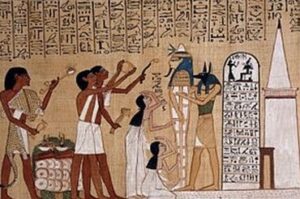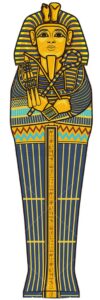Do you find this weird? The Ancient Egyptians believed in life after death, and their belief was that parts of them went to the Afterlife, in fact those parts that went into the Afterlife were:
- The Ka, Ancient Egyptian conception of the soul, which could bring the corpse back to life.
- The Ba, the spirit, which had the head of the deceased and the body of a hawk.
- Their shadow and name also survived.
They felt that after death you travelled to the underground world, called Duat. They were very aware that they were going to a dangerous place, so dangerous that at some point they would come across a lake that would be filled with snakes and there were other parts of the afterlife where they would come across lakes of fire! It should be remembered that they were taught they would only meet these horrors if they had been a bad person.
 For this reason, the Ancient Egyptians used spells to protect themselves from the terrible dangers that the Afterlife could throw up for them. They believed, for example, that your Kay, your soul, would return to your body in the Afterlife. Isn’t that just a tiny bit strange, or is it just me?
For this reason, the Ancient Egyptians used spells to protect themselves from the terrible dangers that the Afterlife could throw up for them. They believed, for example, that your Kay, your soul, would return to your body in the Afterlife. Isn’t that just a tiny bit strange, or is it just me?
This is the reason why the Ancient Egyptians created “mummification” with the aim being to protect the body against decomposition. In fact, it was only by examining the mummified remains of the pharaohs that the archaeologists have been able to learn so much about the Egyptian world and its beliefs.
Mummification was weird!
You see it involved removing important organs, these organs were then embalmed, so the deceased could be preserved as a whole.
It was a complicated process that went like this:
- First, the body was taken to the ‘Beautiful House’.
- Embalmers then removed the liver and lungs.
- They would then be dried.
- Now they are placed in special vessels called ‘canopic jars’.
- Finally, the brain was removed.
- But, as the heart had to be weighed by the gods, it was left!
The heart was important as it was thought that if you had been good, your heart would be returned to you and you would be allowed to live in the Afterlife. On the other hand, if you had been bad, your heart was given to the Devourer of the Dead, and you would not go into the Afterlife.
It was all a bit frightening, but on the assumption that you had got through this, which the Egyptians assumed you would, points they needed:
- To stop the body rotting, so it was covered in crystals of Natron.

- It was then, once they had removed the organ’s, that they were stuffed!
- Finally, it was wrapped in linen bandages.
The mummy was now placed in a beautiful and fantastic sarcophagus. A richly decorated coffin covered with designs and spells to protect the occupant from the perils of the Afterlife, which was finished with an idealised representation of the deceased’s face. 20history.
That is how the Ancient Egyptians dealt with death!
At Educational Musicals our sister site we have written a musical The Boy King – The Legend of Tutankhamun, and his journey to the afterlife. For just £29.99 you can download it today with everything you need for your children to perform it, including no performance fees. Go to
 The download gives you:
The download gives you:
- The Script, with stage directions already in place
- Both the performance and backing tracks as MP3 files
- The libretto music score allowing you to play the music if you want to have live music.
- An Art pack showing how you can make the scenery, costume and props from recycled materials.
- An historical fact pack explaining the true facts.
Just click on The Boy King – The Legend of Tutankhamun.
Isn’t history interesting?
10 questions on this subject:
- What were the main parts of a person that the Ancient Egyptians believed went to the Afterlife?
- What is the Ka in Ancient Egyptian belief?
- How did the Ancient Egyptians describe the Ba?
- What is Duat in Ancient Egyptian mythology?
- What dangers did the Ancient Egyptians believe they would encounter in Duat?
- Why did the Ancient Egyptians use spells related to the Afterlife?
- What was the purpose of mummification in Ancient Egyptian culture?
- What organs were removed and embalmed during the mummification process?
- Why was the heart left in the body during mummification?
- What steps were taken to preserve the body after organ removal in the mummification process?
For more information go to:
https://en.wikipedia.org/wiki/Ancient_Egyptian_conception_of_the_soul
https://www.historymuseum.ca/cmc/exhibitions/civil/egypt/egcr04e.html
© Tony Dalton


